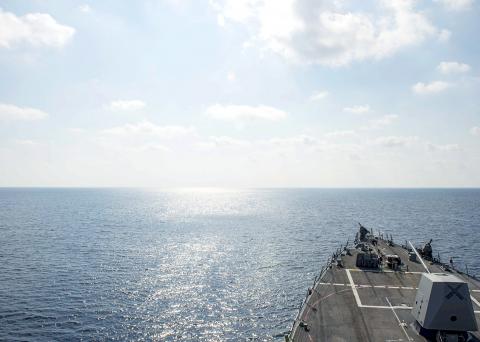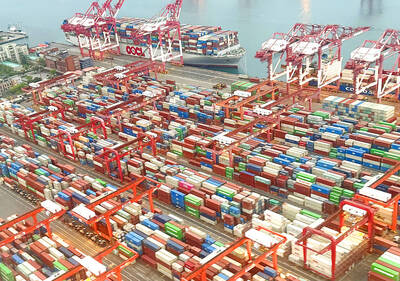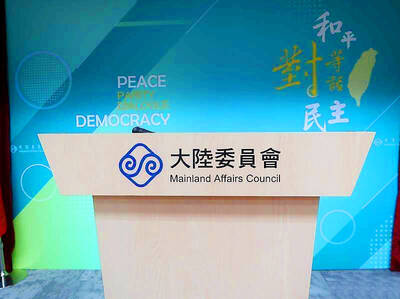A US Navy warship sailed close to a disputed reef in the South China Sea yesterday, a US Department of Defense official said, prompting anger in Beijing, which denounced the patrol as illegal and a threat to peace and stability.
Guided missile destroyer the USS William P. Lawrence traveled within 12 nautical miles (22.2km) of the Chinese-occupied Fiery Cross Reef (Yongshu Reef, 永暑島) in the Spratly archipelago (Nansha Islands, 南沙群島), Department of Defense spokesman Bill Urban said.
The so-called freedom of navigation operation was undertaken to “challenge excessive maritime claims” by Taiwan, China and Vietnam, which are seeking to restrict navigation rights in the South China Sea, he said.

Photo: EPA
“These excessive maritime claims are inconsistent with international law as reflected in the [UN] Law of the Sea Convention in that they purport to restrict the navigation rights that the United States and all states are entitled to exercise,” Urban said in an e-mailed statement.
Beijing and Washington have traded accusations that the other is militarizing the South China Sea as China undertakes large-scale land reclamations and construction on disputed features while the US has increased its patrols and exercises in the region.
Facilities on Fiery Cross Reef include a 3km runway and Washington is concerned China plans to use it to press its extensive territorial claims at the expense of weaker rivals.
Chinese Ministry of Foreign Affairs spokesman Lu Kang (陸慷) said the US ship illegally entered Chinese waters and was tracked and warned.
“This action by the US side threatened China’s sovereignty and security interests, endangered the staff and facilities on the reef, and damaged regional peace and stability,” the spokesman said at a daily news conference.
The Pentagon last month called on China to reaffirm it has no plans to deploy military aircraft in the disputed Spratlys after Beijing used a military plane to evacuate sick workers from Fiery Cross.
“Fiery Cross is sensitive because it is presumed to be the future hub of Chinese military operations in the South China Sea, given its already extensive infrastructure, including its large and deep port and 3,000m runway,” said Ian Storey, a South China Sea expert at Singapore’s ISEAS Yusof Ishak Institute.
“The timing is interesting, too. It is a show of US determination ahead of [US] President Obama’s trip to Vietnam later this month,” Storey added.
Speaking in Hanoi, US Assistant Secretary of State for East Asia Daniel Russel said freedom of navigation operations were important for smaller nations.
“If the world’s most powerful navy cannot sail where international law permits, then what happens to the ships of navy of smaller countries?” Russel told reporters before news of the operation was made public.
“If our warships can’t exercise its legitimate rights under international law at sea, then what about the fishermen, what about the cargo ships? How will they prevent themselves from being blocked by stronger nations?” Russel added.
US naval officials believe China has plans to start reclamation and construction activities on Scarborough Shoal (Huangyan Island, 黃岩島), which is north of the Spratlys within the 200 nautical mile (370km) exclusive economic zone claimed by the Philippines.
The move also comes as tough-talking Davao Mayor Rodrigo Duterte looks set to take the Philippines’ presidency. He has proposed multilateral talks on the South China Sea.
Criticism of China over the South China Sea would rebound like a coiled spring, a Chinese diplomat said on Friday last week, as a US warship visited Shanghai against a backdrop of rising tension in the region.

CARROT AND STICK: While unrelenting in its military threats, China attracted nearly 40,000 Taiwanese to over 400 business events last year Nearly 40,000 Taiwanese last year joined industry events in China, such as conferences and trade fairs, supported by the Chinese government, a study showed yesterday, as Beijing ramps up a charm offensive toward Taipei alongside military pressure. China has long taken a carrot-and-stick approach to Taiwan, threatening it with the prospect of military action while reaching out to those it believes are amenable to Beijing’s point of view. Taiwanese security officials are wary of what they see as Beijing’s influence campaigns to sway public opinion after Taipei and Beijing gradually resumed travel links halted by the COVID-19 pandemic, but the scale of

TRADE: A mandatory declaration of origin for manufactured goods bound for the US is to take effect on May 7 to block China from exploiting Taiwan’s trade channels All products manufactured in Taiwan and exported to the US must include a signed declaration of origin starting on May 7, the Bureau of Foreign Trade announced yesterday. US President Donald Trump on April 2 imposed a 32 percent tariff on imports from Taiwan, but one week later announced a 90-day pause on its implementation. However, a universal 10 percent tariff was immediately applied to most imports from around the world. On April 12, the Trump administration further exempted computers, smartphones and semiconductors from the new tariffs. In response, President William Lai’s (賴清德) administration has introduced a series of countermeasures to support affected

Pope Francis is be laid to rest on Saturday after lying in state for three days in St Peter’s Basilica, where the faithful are expected to flock to pay their respects to history’s first Latin American pontiff. The cardinals met yesterday in the Vatican’s synod hall to chart the next steps before a conclave begins to choose Francis’ successor, as condolences poured in from around the world. According to current norms, the conclave must begin between May 5 and 10. The cardinals set the funeral for Saturday at 10am in St Peter’s Square, to be celebrated by the dean of the College

CROSS-STRAIT: The vast majority of Taiwanese support maintaining the ‘status quo,’ while concern is rising about Beijing’s influence operations More than eight out of 10 Taiwanese reject Beijing’s “one country, two systems” framework for cross-strait relations, according to a survey released by the Mainland Affairs Council (MAC) on Thursday. The MAC’s latest quarterly survey found that 84.4 percent of respondents opposed Beijing’s “one country, two systems” formula for handling cross-strait relations — a figure consistent with past polling. Over the past three years, opposition to the framework has remained high, ranging from a low of 83.6 percent in April 2023 to a peak of 89.6 percent in April last year. In the most recent poll, 82.5 percent also rejected China’s